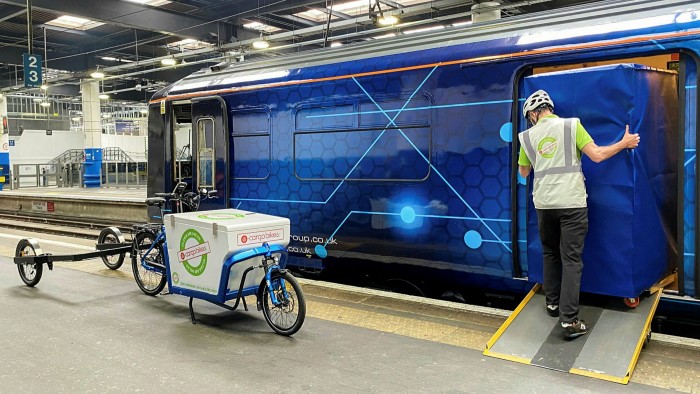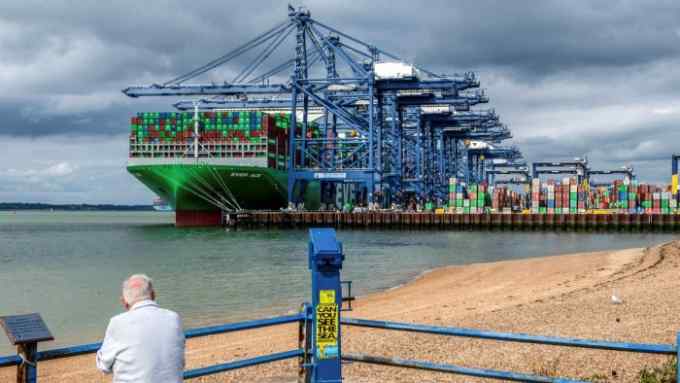High speed UK rail freight service aims to overtake trucks for logistics

Roula Khalaf, Editor of the FT, selects her favourite stories in this weekly newsletter.
The ageing electric passenger train that pulled into London’s Euston station on the evening of July 7 initially looked unremarkable. But, when the doors slid open, the new arrival’s revolutionary potential became evident.
The interior of the train, operated by Orion High Speed Logistics, had been stripped of seats and fitted with metal floors and equipment to hold wheeled cages full of retailers’ stock. Minutes after arriving, the cages were being hauled out of the station and into central London on bikes powered by a mixture of human and battery power.
These events illustrate the possibilities presented by Orion, part of a company called Rail Operations Group. It hopes that a fleet of converted, 100mph passenger trains can exploit the trend towards decarbonisation to compete in new markets for UK rail.
The trains have converted from passenger service by having small diesel engines and batteries fitted to enable them to negotiate short stretches of unelectrified line. But they mostly run on live overhead wires and produce no direct emissions.
Paul Orchard, managing director of Orion High Speed Logistics, says the company is receiving growing interest in its service from logistics providers in light of the rising cost of fuel in the UK and the shortage of truck drivers.
“It will deliver a greener end-to-end transport solution and, of course, a lot of these companies now are a lot more focused on the environment and their own decarbonisation targets,” he says.
Orion’s planned launch is part of a worldwide revival in the use of rail for logistics, including the use of trains to move goods such as maritime shipping containers in large volumes, replacing trucks or even ships on some routes.
In the UK, in the three months to June this year, volumes of intermodal traffic — containers carried on rail — were 22.5 per cent up on the same quarter in 2020. Volumes were still 3.8 per cent behind the same quarter of 2019, but the UK’s Office of Road and Rail attributed that fall to a worldwide shortage of shipping containers.
Aymeric Chandavoine, global head of logistics and services for AP Moller-Maersk, the container shipping and logistics group, says interest in using rail is accelerating worldwide.
“It’s a green, efficient transportation mode,” he explains.
John Smith, managing director of GB Railfreight, the UK’s third-biggest railfreight operator by traffic volumes, says three of its biggest customers now are companies that were traditionally solely truck operators. The company expects to add four daily round-trips of container — or intermodal — trains next year, on top of the 24 it currently runs on most weekdays.
According to Smith, the shift has created more attractive roles for truck drivers, who now make multiple short delivery trips daily, from a railfreight terminal to customers, rather than long-haul end-to-end trips.
The UK currently has a shortage of 100,000 qualified truck drivers, according to estimates.
“They’re contracting us on the trunk haulage, heavy volume leg, which means they then can get better efficient use out of lorry drivers,” Smith says of his customers.
For Orchard, Orion’s attraction is that the company’s converted passenger trains can run directly into city centre stations, reaching markets that are currently served almost exclusively by trucks and vans.
He points out that many trucks driving into London’s Ultra Low Emissions Zone — which since October 25 has covered parts of the city inside the north and south circular roads — now have to pay £300 a day.
“It’s perfect timing for rail,” Orchard says of the charge’s expansion. “The whole idea of the train [going into Euston] was just to highlight how easy it is to open the gate at the end of the platform and go straight out.”
Because its train nearly matches the speed of the fastest passenger trains, Orion should be able to outpace the trucks that traditionally carry express parcels and other premium express freight.
Orion expects its main market to be in replacing trucks on trunk routes between England’s south and midlands and Scotland’s central belt. The challenge, so far, has been to find enough southbound traffic from Scotland back to England to make the service economic.
The company nevertheless expects to start operations during November this year with a launch customer that has substantial volumes to move and a number of suitable facilities for handling the traffic.
“The amount of interest shown has just increased, almost month by month,” Orchard says. “The problem we have is the train needs to be filled in both directions.”
GB Railfreight’s Smith expects continued growth in long-established forms of railfreight.
As well as its traditional market of moving shipping containers from ports to distant inland terminals, the company now has some business hauling containers between two inland terminals — a business where rail freight operators previously struggled to be competitive.
The dynamic of everything is now favouring rail”, Smith believes. “People are beginning to see us as the solution,” he says.
According to Maersk’s Chandavoine, such stories of enhanced competitiveness for rail are common. Maersk Logistics, for example, now charters trains for 250 round trips annually between Asia and Europe — a market where the mode of transport has been competing only in the last 15 years.
Trains fill a gap in speed and price between high-cost, carbon-intensive air freight and lower-cost, far slower ships, according to Chandavoine.
“It’s what we have to really look at when we see the challenges we’re facing today across the industry,” Chandavoine says, noting rail’s ability to help overcome such problems as truck driver shortages and decarbonisation.
“We’re really seeing many, many advantages for the customer,” he adds.
“We’ll never replace trucking — but this option of rail, air, ocean, truck brings different alternatives for the customers.”

Comments